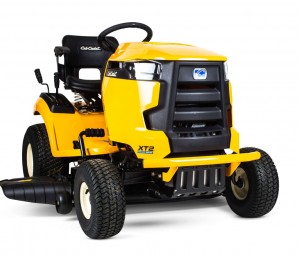Most problems with small engines can be traced to fuel. What kind of fuel should you be using in your Cub Cadet, and how should you be using it to ensure your equipment works reliably?
Which Type of Gasoline is Best?
Ethanol can cause problems because it’s hygroscopic: over time, it absorbs water and will separate from the gasoline it’s mixed with, causing problems with starting and ignition. This isn’t a problem in cars since the fuel is usually burned shortly after purchase, but fuel can sit in outdoor power equipment for months.
Unfortunately, some owners have taken this to mean that fuel problems can be eliminated by switching to ethanol-free fuel. This just causes another problem: without the solvent properties of ethanol, modern gasoline quickly forms gums that varnish fuel components and make the fuel harder to burn. This also causes problems with starting and ignition.
All engines used in recent Cub Cadets regardless of manufacturer are designed to run just fine on ethanol blends up to 10%. When it comes to fueling your equipment, the most important factors are freshness, which is affected by both when the fuel was purchased and whether it has been treated with a stabilizer. The effect of these factors depends on the engine you’re using.
Two Stroke Engines
A two-stroke engine uses the crank to push air and fuel in and move exhaust gases out, which means it can’t keep oil in the crankcase like a four stroke engine. Instead, they depend on oil mixed with the fuel for lubrication.
Modern Cub Cadet two strokes like the 27cc motor found in some of their current string trimmers need oil mixed with the fuel at a 50:1 ratio. That means 2.6 ounces of oil needs to be mixed with every gallon of gasoline, or 20 ml for every liter. Older engines may need a 40:1 ratio, which is 3.2 oz/gallon or 25 ml/liter, or 32:1, which is 4 oz/gallon or 31.25 ml/liter. It’s important to get exactly the right ratio: if there’s too little oil, the engine won’t be protected from friction wear, and if there’s too much oil, the fuel mixture will be lean, leading to high combustion temperatures and overheating.
Two stroke engines are the most sensitive to stale fuel. Gasoline should always be mixed with a stabilizer, and it should be used within one month of purchase. For this reason, the amount of oil mixed fuel you keep on hand should be minimal, and any leftover fuel should be run through the engine before storing it for the off-season.
Four Stroke Engine with Carburetors
Whether the motor was made by Cub Cadet, Kawasaki, Kohler, Honda or Briggs & Stratton, the fuel recommendations remain the same: untreated fuel can be used for up to a month after purchase, while treated fuel can be used for up to three months.
When it’s time to store your equipment, the motor should be run for a few minutes with treated fuel, then the fuel system should be drained. This keeps old gas from lacquering inside the fuel system, and any fuel left over is less likely to cause problems.
Fuel Injected Engines
A fuel injector sprays a fine mist of fuel into the intake, helping it atomize and mix with the air. This not only improves fuel economy and performance compared to carburetor-fed engines, it also works better with less volatile fuels.
Kohler’s Aegis V-Twin, found in some Cub Cadet UTVs, needs its fuel to be treated just like a carburetor-equipped engine, with straight gasoline used within a month of purchase or treated fuel within three months of purchase. However, the fuel system doesn’t need to be drained before storage if the fuel inside is stabilized.
Cub Cadet’s fuel injected engines can run on straight fuel, only requiring stabilizer when being put into storage. These engines can also run on gasoline blended with up to 20% ethanol so they can be used with E15.
Getting Rid of Old Fuel
Regular gasoline can be poured into your car’s gas tank. Since it’s fuel injected and the stale fuel it gets will be mixed with a large quantity of fresh fuel, the engine should have no problem burning it.
If you have leftover fuel mixed with two stroke oil, contact your local recycling center to find out where it can be disposed: pouring this fuel into your car’s fuel tank could damage oxygen sensors and other sensitive components.
Repairing Your Cub Cadet’s Fuel System
Have a cracked fuel line or dried out seals around the carburetor? You can get everything you need to fix your Cub Cadet at www.cubparts.com. Our site has built in parts diagrams and descriptions to help you find what you need, and you can have your order shipped to any address in the U.S. and Canada.

